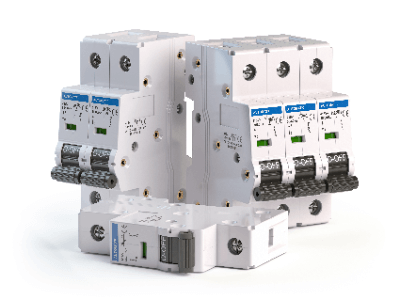What Is a Circuit Breaker?
 A circuit breaker is an electrical device capable of interrupting a circuit where an accidental current flows.
A circuit breaker is an electrical device capable of interrupting a circuit where an accidental current flows.
Circuit breakers for low voltage include wiring circuit breakers to detect overcurrents and ground leakage circuit breakers to detect leakage currents. Circuit breakers for high voltage are used in conjunction with protective relays because they are not equipped with accidental current detection functions.
Uses of Circuit Breakers
Wiring circuit breakers are also used as safety breakers in ordinary homes. Circuit Breaker is a device that interrupts a circuit in general, but the wiring circuit breaker installed in a home switchboard is called a safety circuit breaker.
The purpose of installing circuit breakers is to protect circuits and people from accidental currents, such as short circuits and ground faults. Since these can cause electric shock or fire, they are always installed in electrical products and switchboards.
Principle of Circuit Breaker
Wiring circuit breakers are generally of the thermodynamic electromagnetic type, utilizing the deformation of bimetal caused by overcurrents. When an overcurrent flows, the bimetal generates heat and deforms to release the latch, thereby breaking the circuit.
Thermodynamic electromagnetic wiring circuit breakers can be restored by manually returning the latch after the bimetal has cooled and returned to its original shape. RCD circuit breakers monitor the current in a circuit and interrupt it if there is a difference in traffic. If the circuit is properly insulated, the outgoing and incoming current values will be equal.
The difference between the outgoing and incoming currents is called leakage current, which is detected by the magnetic field of the zero-phase current transformer built into the RCD circuit breaker. Vacuum circuit breakers are mainly used for high-voltage circuits. Vacuumcircuit breakers are circuit breakers that turn off the arc by creating a vacuum at the opening and closing points of contact.
When a circuit with a current flowing through it is opened, a discharge phenomenon called an arc is generated. At high voltages, the arc discharge cannot be broken, and the contact point will burn up. Extinguishing the arc discharge is called quenching, and every high-voltage Circuit Breaker has a function that can quench high-voltage arc discharges.
Types of Circuit Breakers
Circuit breakers that protect against short-circuit currents of high-voltage or extra-high-voltage voltages have the function of quenching arcs, as mentioned above. Based on the arc quenching mechanism, the following types of circuit breakers are available.
1. Aerial Circuit Breaker (ACB)
Low-voltage circuit breakers are generally used because they can be arc-quenched in the air without any problem. General low-voltage circuit breakers, such as safety breakers, are applicable to air circuit breakers .
2. Gas Circuit Breaker (GCB)
A circuit breaker that quenches the arc by spraying an inert gas on the contacts when opening the circuit. Sulfur hexafluoride (SF6) gas is used as an inert gas, but because SF6 is a greenhouse gas, it is a circuit breaker that should be used with caution.
3. Oil Circuit Breaker (OCB)
A circuit breaker that quenches the arc using insulating oil. Since its dielectric strength is inferior to that of a vacuum, this type of circuit breaker is rarely used today. In the past, polychlorinated biphenyls (PCBs) were used as insulating oil, but the production of PCBs is now prohibited.
4. Vacuum Circuit Breaker (VCB)
A circuit breaker that extinguishes an arc by creating a vacuum at the open/close contact point. Vacuum circuit breakers are the most common type of compact high-voltage circuit breaker. They have few actuators and are easy to maintain.
Other Information on Circuit Breakers
Difference Between Circuit Breakers and Breakers
There is no difference between circuit breakers and breakers. Breaker is an abbreviation for circuit breaker.